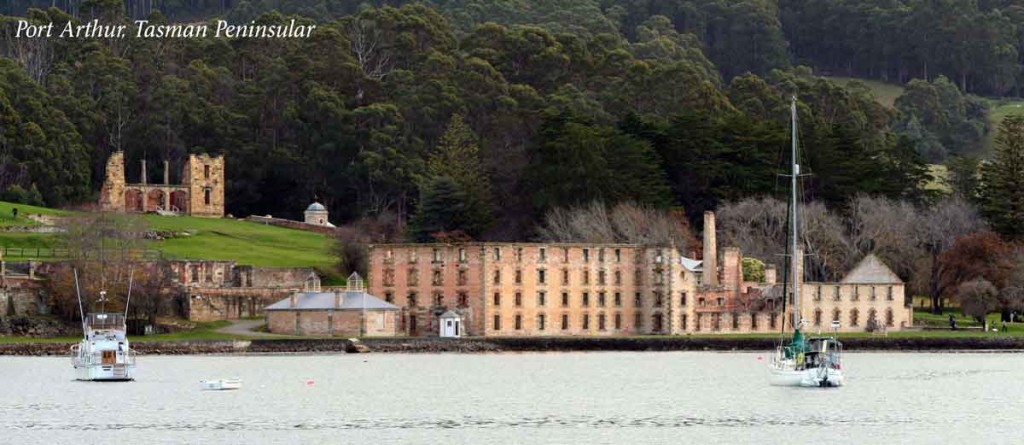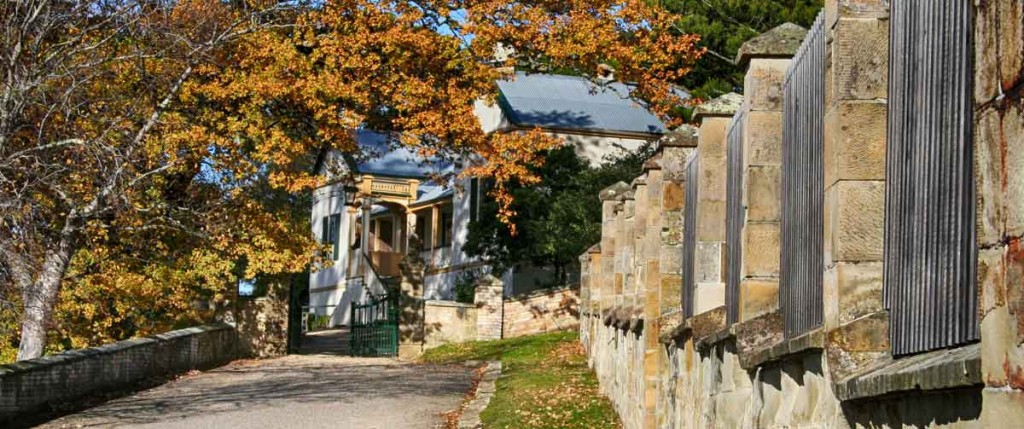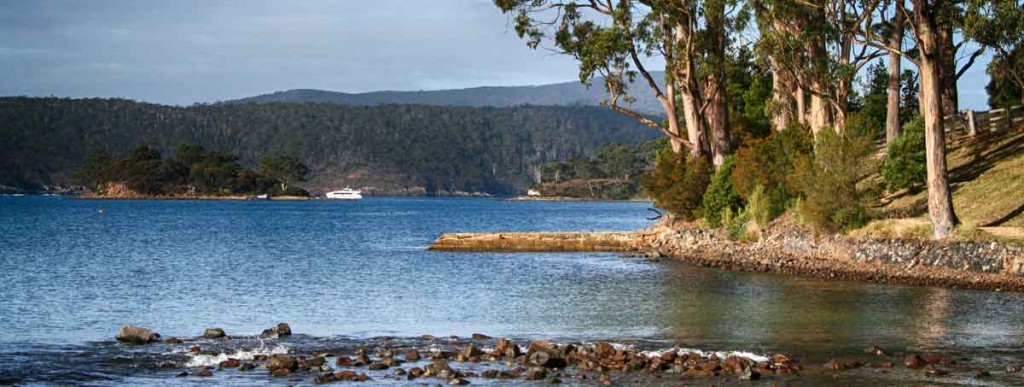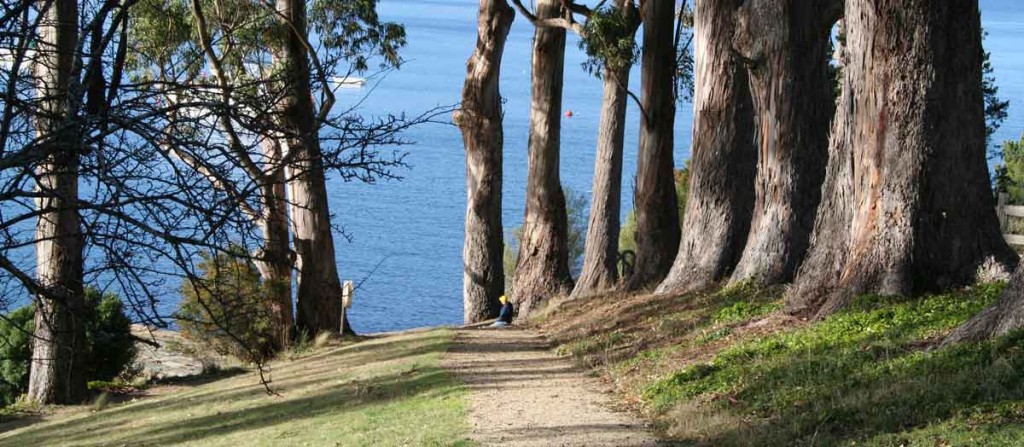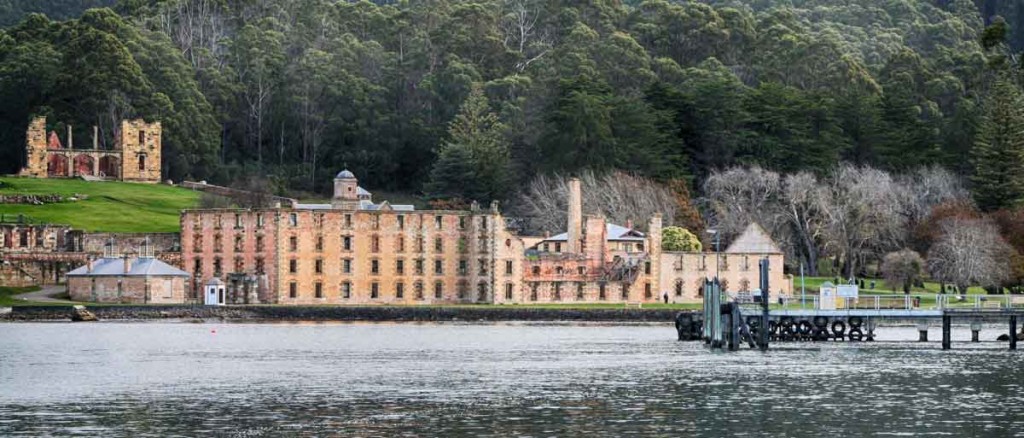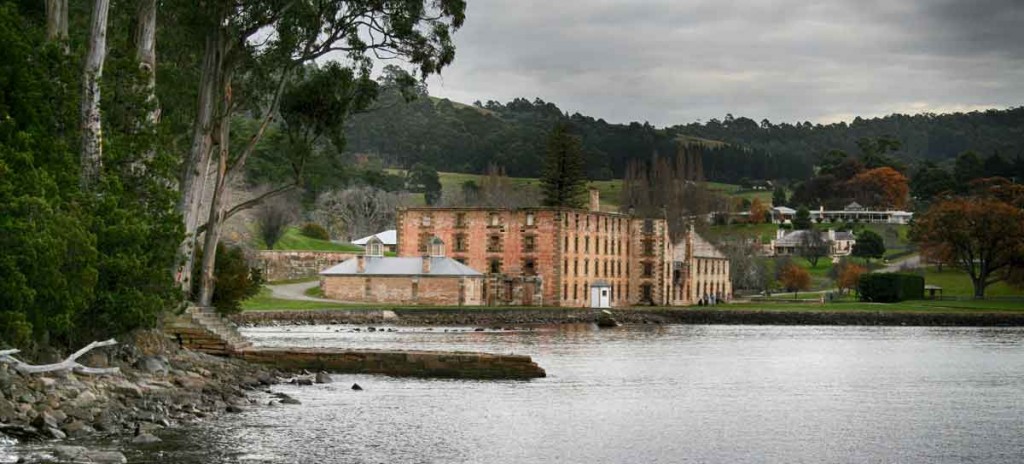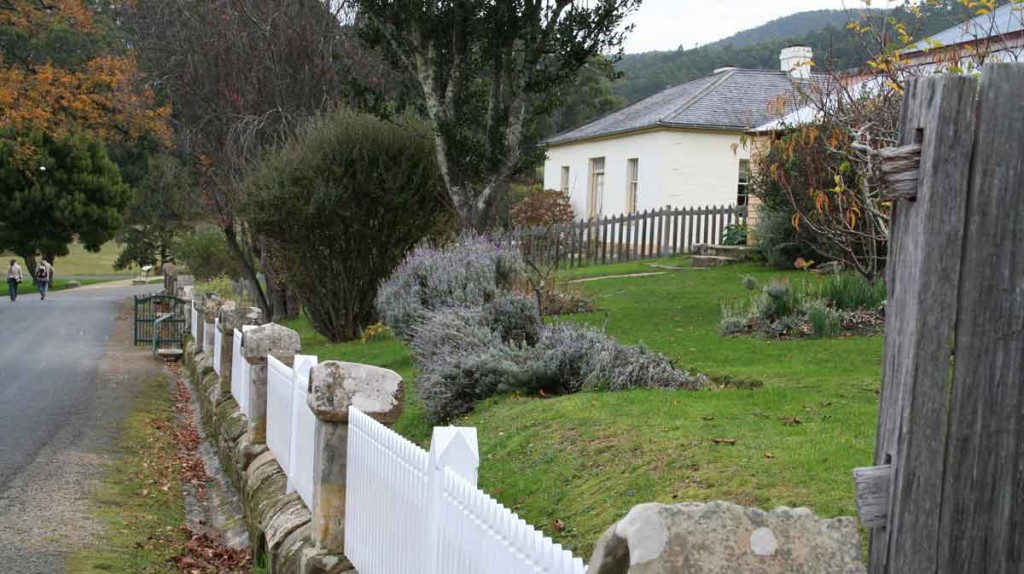Click here to buy our feature DVD “Tasmania, it’s History, it’s heritage” with bonus “Ghosts of Port Arthur”
With as many as 250,000 visitors a year, it’s safe to say that the Port Arthur Historic Site is Tassie’s most popular attraction. This UNESCO World Heritage-listed collection of buildings, many of them ruins, offers a fascinating glimpse into Australia’s convict past and what life was like for those who were caught on the wrong side of the law.
Where is Port Arthur?
The Port Arthur Historic Site is located in the small town of Port Arthur, in the southern part of the Tasman Peninsula. It lies along the shores of Carnarvon Bay and as the crow flies, it’s about 60 km to the southeast of Hobart. The town was named after Sir George Arthur, who was Lieutenant Governor of Van Diemen’s Land from 1823 to 1837 and was the man behind the foundation of the settlement.
Port Arthur’s heyday: The convict era
In 1827, Lieutenant Governor Arthur proposed the idea of starting a penal settlement on the Tasman Peninsula. It was the perfect place to send convicts to, since the only way to get there over land involved crossing a narrow isthmus that could easily be guarded. Carnarvon Bay was the ideal site too, since it’s on the western shore of Port Arthur, a natural harbour. This meant that ships could easily reach the settlement to bring convicts and supplies while taking away the timber, coal and other natural resources the peninsula had to offer.
In 1830, a small timber station was started at what would become Port Arthur and three years later the settlement became a fully fledged penal colony, mainly for repeat offenders. The house of the first Commandant, Charles O’Hara Booth, was built in 1833 and was a wooden cottage that overlooked the settlement. Over time, the cottage was replaced by a more permanent structure that was more in keeping with the Commandant’s stature as the highest-ranking official here. Today the well-preserved house is a museum.
The dockyard, complete with Master Shipwright’s House, was built soon afterwards and from 1834 to 1848 it was Van Diemen’s Land’s busiest ship yard. It was one of only three convict-built dockyards in the British Empire and the convicts also built the hundreds of ships that came from here. Most of the convicts assigned to this job had no skills for building ships and many of them were boys from the boys’ penitentiary that was founded at Point Puer, across the bay, in 1834. The idea was to teach these convicts a trade so that they could make a living once they were reformed. The first Master Shipwright was John Watson but in 1836 he was replaced by David Hoy, who held the post until 1848.
Both Watson and Hoy took great pride in their work and were committed to helping the convicts turn their lives around. One of their pupils was Walter Paisley, who was thirteen when he was transported to Van Diemen’s Land for housebreaking and then sent to Point Puer. One of the first arrivals here, Paisley was rebellious and often spent time in solitary confinement. The official records suggest that even after Point Puer, Paisley never managed to stay out of trouble. However, in 1871, when he was fifty-two, he built a wooden dinghy that is now in Hobart’s Maritime Museum of Tasmania.
The dockyards were built not in the main settlement but a little to the northeast to keep visiting sailors away from most of the convicts. The Convict Church, however, was built overlooking the main settlement and could accommodate more than a thousand people. It was built between 1836 and 1837 and because the parishioners were from many different denominations, the church was never consecrated. During its construction, a convict named William Riley murdered another inmate, Joseph Shuttleworth, with a pickaxe and said, ‘I am satisfied.’ Riley would never say why he killed Shuttleworth and was hanged for this deed. It is said that at around 4pm on Monday afternoons you can hear ghostly church bells ringing near the site.
Near the prisoners’ barracks, the hospital was built between 1841 and 1842. This building was the third hospital built at the settlement and in addition to the wards, it had a morgue, a laundry, a kitchen and a baking room. The first medical officer at Port Arthur arrived in 1832 and since he was also the catechist, he was responsible for the convicts’ spiritual health too. He was Dr Thomas Coke Brownell and after he left in 1833, he returned twice more to serve as medical officer.
To the southwest of the church is what is known as the Civil Officers Row. The Parsonage and the Accountant’s House here, date from 1842. The Roman Catholic Chaplain’s House was built in 1843. The Magistrate’s and Surgeon’s House followed in 1847 and the Junior Medical Officer’s House in 1848. The latter was originally built for Thomas Lempriere, the Commissariat Officer, and like the Parsonage it is now furnished much like it was back in the day.
Probably the most photographed structure at Port Arthur is the Penitentiary, which overlooks Mason Cove. Construction started in 1842 but the building’s original purpose was to serve as a flour mill and granary. The plan was to supply the daily bread of the settlement’s convict population, which numbered about 3,500 by 1844. However, the project was a failure and between 1854 and 1857 the building was converted into the penitentirary, which could accommodate more than 480 convicts.
A little further inland from the Penitentiary is the Separate Prison, which was built in 1850. By this time the authorities had decided that the floggings and other physical punishments weren’t the way to reform convicts. Instead, psychological punishment would encourage them to contemplate their deeds and change their ways. One form of psychological punishment was to reward well-behaved prisoners with extra food while those who needed to be punished received only a little bread and water. Another punishment was the so-called Silent System, where a prisoner would be hooded and forced to stand in silence, thinking about the wrongs he had committed. The prisoners had to spend 23 hours a day in their cells and when they were let out for exercise or church, they had to wear masks so that they couldn’t communicate with one another. The wardens even wore felt slippers so that the Separate Prison would be completely silent.
It is no wonder that some prisoners went insane or that one, William Carter, hanged himself in his cell. Neither is it unexpected that the Separate Prison is said to be haunted. There was a special punishment cell where a prisoner was let out for an hour after four days and spent the rest of his time in complete darkness. Legend has it that you can sometimes hear the screams of a boy who spent two weeks in this cell while he was awaiting execution.
One prisoner who may have had it better than most at Port Arthur was William Smith O’Brien, leader of the Young Ireland rebellion. He was transported to Van Diemen’s Land for high treason and sent to Maria Island. Once there, he tried to escape but was betrayed and then sent to Port Arthur in 1850. Smith O’Brien’s Cottage, which is now a museum house, is located to the south of the Penitentiary. Originally it was a stable but it was converted to house the Irish politician, who spent his days working in the garden, reading and keeping a journal. He was kept in isolation from the other prisoners and stayed at Port Arthur until 1854.
Port Arthur was regarded as a prison from which there was no escape. Rumours were spread that the waters around the Tasman Peninsula were infested by sharks and the only escape route over land was blocked at Eaglehawk Neck, where the isthmus joins the peninsula to the Forestier Peninsula. Here, soldiers were stationed along both sides of the bay while a line of ferocious dogs was positioned across the isthmus. There was a semaphore station too, to convey messages about prisoners trying to escape.
Henry Singleton, also known as Richard Pinches, was in Port Arthur for the third time when he had a great opportunity to escape. He was in the Separate Prison when some of the guards decided to get drunk and gave him a set of keys so he could let them in later on. He made copies of these keys but then decided to hand them in instead. The guards were fired.
Of course some prisoners did try to escape. Billy Hunt, a former strolling actor, thought he had a foolproof plan when he covered himself in a kangaroo hide and tried to hop across the isthmus. Unfortunately for him, the soldiers on duty here received small rations and were delighted at the prospect of eating kangaroo. When they aimed their guns to shoot him for the pot, he was forced to throw off his disguise and let himself be re-arrested.
Martin Cash was more successful. He actually swam across the bay but was quickly captured. In 1842, on Boxing Day, Cash made another dash for it with two fellow inmates. When they got to Eaglehawk Neck, they tied their clothes in bundles on top of their heads and swam across the bay. However, they lost their bundles along the way and had to rob a road gang’s hut for clothes. They became a gang of outlaws known as Cash and Co. Cash then went to Hobart and got involved in a gunfight which led to a constable’s death. He was convicted of murder and was about to be hanged when he received a reprieve and was sent to Norfolk Island. There he became a constable and got married. He later became an overseer at the Royal Tasmanian Botanical Gardens, a brothelkeeper in Christchurch in New Zealand and, in 1863, a free man.
The officers living at Port Arthur often had their families with them. In 1846, Commandant William Champ decided to create an ornamental garden at the settlement, mainly for the enjoyment of the officers’ wives. He wrote to his mother in England to send him seeds and plants and the Government Gardens became a much admired feature of Port Arthur. Today you can buy seeds from some of those plant varieties at the site’s gift shop.
Even though convict transportation had ended in 1853, most of the prisoners at Port Arthur were sentenced for crimes committed in the colony, so the settlement remained a busy centre of industry. When most of the useful timber around the nearby Cascades Probation Station had been cut down by 1856, the sawmill and tramway rails were moved to Port Arthur, which now became the main producer of timber on the peninsula. However, by the late 1860s much of the timber here had been depleted as well. Besides, most of the convicts were becoming too old to handle the hard physical labour. Between 1863 and 1864 a Pauper’s Depot was built, while the Asylum followed between 1864 and 1868.
Those who died at Port Arthur were buried on the Isle of the Dead, a little offshore from Point Puer. In the years between 1833 and 1877, when the prison was closed down, more than 1,000 people were buried here. In the 1870s, one of the gravediggers on the Isle of the Dead was Mark Jeffrey, who was a Port Arthur regular due to his violent temper. The authorities actually sent him to the Isle of the Dead to keep him away from the other prisoners. He was happy enough with this assignment until the night when, according to him, the devil visited him in his hut. He begged to be removed from the island and eventually died in Launceston.
After the convicts
After the penal settlement at Port Arthur closed in 1877, the land was auctioned off and the site was renamed Carnarvon. In 1895 and 1897, fires swept through the new township and destroyed many of the old buildings, including the Hospital, the Penitentiary and the Separate Prison. However, the community built new infrastructure such as a post office and cricket and lawn tennis clubs.
People looking for the thrill of seeing first-hand the notorious prison started coming soon after the penal settlement’s closure and the community quickly began to build a tourism industry complete with hotels and museums. In 1927 they renamed the township Port Arthur. Since 1987, the Port Arthur Historic Site Management Authority has been responsible for running the site.
One of the most heartbreaking attractions at Port Arthur does not date from the convict era but from 2000. The Port Arthur Memorial Garden near the ferry terminal commemorates the victims of an event that shook the world. On 28 April 1996, a lone gunman went on a shooting spree at Port Arthur, killing 35 people and wounding 23. This is still one of history’s deadliest mass shootings by one person. Australia responded with very strict gun-control laws which led to a dramatic drop in gun-related crimes. The killer is serving 35 life sentences in Hobart, where he is kept in solitary confinement.
The beautiful, peaceful garden is on the site of what used to be the Broad Arrow Cafe, where 20 people lost their lives that day. A plaque lists the names of the 35 dead.
Visiting Port Arthur
To get to Port Arthur, you can either take a cruise or travel by road. Cruises from Hobart are available in the summer and are a great way to see the spectacular scenery along the Tasman Peninsula coastline. They take about two and a half hours.
The drive from Hobart takes about an hour and a half. The easiest and most direct route is along the Tasman Highway, also known as the A3, to Sorell and then continuing along the Arthur Highway, the A9, which ends in Port Arthur. Tassielink has a public bus service from Hobart too, operating from Mondays to Saturdays.
You can buy your Site Entry Pass at the Visitor Centre in Port Arthur. This pass allows you entry to the site on two consecutive days. It not only gives you access to the many attractions at the site but also includes a guided walk and a harbour cruise. You can upgrade to a Ticket of Leave, which allows you free and unlimited general site entry for the next two years.
A great option is to spend a few dollars more and book an optional daytime tour package which gives you entry to the site but also includes a trip to the Point Puer Boys’ Prison and/or the Isle of the Dead.
One of the most fun but hair-raising ways to explore Port Arthur is on a ghost tour, which requires an After Dark Pass. These tours take place on the last Saturday of every month and are strictly adults only. After all, Port Arthur is said to be one of Australia’s most haunted places, with everyone from Commandant O’Hara Booth to the children of the junior medical officer having made an appearance at one time or another. The cruel conditions at the prison made for many an unhappy spirit too and accidental deaths meant that there are now some lost souls wandering around at night as well. One of these is believed to be the spirit of Private Robert Young.
One night in 1840, Young accompanied a whale boat with a crew of convicts to take the doctor to Point Puer, where one of the boys was ill. It was a cold night in March and Young wasn’t feeling well. When the boat returned to the jetty at Port Arthur, the twenty-year-old soldier fell into the freezing water as he tried to disembark. Two of the convicts jumped in to try and save him but it was dark and by the time they found him, it was too late. It is said that the ghostly figure of a young man with black hair and a white shirt can be seen at the jetty on some nights.
With all the eerie nocturnal activities going on at Port Arthur, nobody will blame you if you don’t want to drive back to Hobart at night. Luckily there are plenty of accommodation options available in the area, from camping to luxury stays. This means too that there’s no reason why you shouldn’t explore the rest of the Tasman Peninsula when you visit the Port Arthur Historic Site.
The grounds at the Port Arthur Historic Site are open daily from 9am until dusk, while the museum houses and buildings open at 9:30 and generally stay open until 5pm. The Visitor Centre closes after the ghost tour has ended. On Christmas Day, the site is open from 9am to 3.30pm but the harbour cruises and most of the tours don’t operate on this day.

